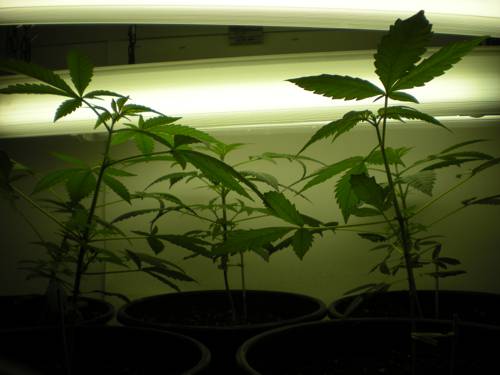
FAQ About Indoor Plant Light Cycles

What is a light cycle for indoor plants?
A light cycle refers to the pattern of light and darkness that indoor plants are exposed to, often meant to simulate natural daylight hours. This cycle is crucial for photosynthesis, plant growth, and flowering. Light cycles can be manipulated using artificial lights to suit the specific needs of different plant species.

How does light intensity affect indoor plant growth?
Light intensity directly influences a plant's photosynthesis process, affecting its growth rate and overall health. Low light intensity can result in slow growth and weak plants, while too much intensity can cause leaf burn. Each plant species has an optimal light intensity range for healthy development, such as bright light for cacti and succulents.

What are the best light cycle durations for common houseplants?
Common houseplants like pothos and peace lily generally thrive with 12 to 16 hours of light per day. However, some flowering plants may require longer light periods to encourage blooming, sometimes up to 18 hours per day. It's important to research the specific needs of each plant species to provide the best light duration.

Can artificial lights replace natural sunlight for indoor plants?
Yes, artificial lights can effectively replace natural sunlight for indoor plants, especially in environments with limited natural light. LED grow lights, fluorescent lights, and high-intensity discharge lights are popular choices, as they provide the necessary spectrum for plant growth. It's crucial to select the appropriate light type and duration based on plant needs.

What are the signs of insufficient light in indoor plants?
Indoor plants that receive insufficient light may exhibit symptoms such as elongated stems, smaller and fewer leaves, pale or yellowish leaf color, and failure to flower. These signs indicate the plant is trying to reach more light, and adjustments to the light cycle or intensity may be necessary.

What types of artificial lights are best for indoor plants?
LED grow lights are a popular choice for indoor plants due to their energy efficiency and full-spectrum light output, which mimics natural sunlight. Fluorescent grow lights are also beneficial, especially for seedlings and leafy greens. High-Intensity Discharge (HID) lights, like metal halide and high-pressure sodium lamps, are suitable for larger growth setups.

Do indoor plants require a period of darkness each day?
Yes, most indoor plants require a period of darkness to support essential processes like respiration and to simulate their natural growth conditions. Typically, plants need about 8 to 12 hours of darkness, though the exact requirement can vary depending on the species.

How can light cycles be adjusted for seasonal changes?
During the winter months, indoor plants may require longer light periods due to reduced natural daylight. Adjusting artificial light timers to extend the light cycle can help mimic spring and summer conditions, promoting healthier growth. Conversely, during summer, natural light cycles might be sufficient.

Can light cycles influence flowering in indoor plants?
Yes, light cycles can significantly influence the flowering process. Many flowering plants are photoperiodic, meaning they require specific light durations to bloom. For instance, short-day plants, like chrysanthemums, require longer nights, while long-day plants, like geraniums, prefer extended daylight hours.

What is the difference between photoperiodism and light intensity?
Photoperiodism refers to an organism's physiological reaction to the length of day or night, affecting processes like flowering and dormancy in plants. Light intensity, on the other hand, concerns the strength of light that plants receive, which influences their photosynthetic activity and energy production.

Why is it important to match light cycles to a plant's native environment?
Matching light cycles to a plant's native environment helps replicate its natural growing conditions, promoting optimal health and growth. Different plants have evolved under specific light durations and intensities, so mimicking these conditions indoors can lead to better growth and yield.

How do low-light conditions impact indoor plants?
Low-light conditions can slow down the growth of indoor plants, leading to leggy, weak growth and potentially making them more susceptible to disease. If a plant adapted to high light is placed in low-light conditions, it may show stunted growth and discolored leaves as a stress response.

How can you measure light intensity for indoor plants?
Light intensity can be measured using a light meter, which provides readings in units called foot-candles or lux. These readings help gardeners ensure that plants are receiving the appropriate amount of light for their specific needs. Some smartphone applications also offer light meter functionality, albeit with less accuracy.

What are the consequences of excessive artificial light for indoor plants?
Overexposure to artificial light can lead to leaf scorching, reduced leaf size, and inhibited growth. Plants can also become stressed, reducing their overall health and vitality. Ensuring that light cycles mimic natural conditions and are aligned with plant-specific needs is key to preventing these issues.

Do all indoor plants require the same light cycle?
No, different indoor plants have varying light cycle requirements based on their native habitats and species characteristics. For instance, succulents prefer bright, intense light conditions, whereas ferns thrive in lower light environments. Understanding each plant's unique needs is essential for providing the optimal light cycle.

How do different colors of artificial light affect plant growth?
Different colors (wavelengths) of light can have varying impacts on plant growth. Blue light supports vegetative growth by encouraging strong stems and leaves, while red light is effective for flowering and fruiting phases. Full-spectrum lights that combine these colors mimic natural sunlight and are generally preferred for a balanced growth cycle.

How do you set up an optimal light cycle for seedlings?
Seedlings typically require more light than mature plants to support their rapid growth and development. Providing 16 to 18 hours of light daily using fluorescent or LED grow lights promotes strong, healthy seedling growth. Consistent light scheduling is crucial to avoid stressing young plants.

Can you use standard household light bulbs for indoor plants?
Standard household bulbs are generally not suitable for growing indoor plants, as they don't provide the full spectrum of light that plants require. While they might offer some illumination, their light output and spectrum are not ideal for photosynthesis. Using specialized grow lights is recommended for better results.

Are there specific light cycle requirements for succulents?
Succulents prefer bright light conditions and usually require about 6 to 8 hours of direct sunlight or equivalent artificial light for optimal growth. Ensuring they receive sufficient light helps maintain their compact shape and enhances their colorful appearance. Adjusting light cycles to prevent overexposure, especially under intense heat, is also important.

How do you acclimate indoor plants to changes in light cycles?
To acclimate indoor plants to changes in light cycles, gradually increase or decrease the duration and intensity of light exposure over a few weeks. This gradual adjustment helps plants adapt without experiencing stress or shock, ensuring they continue to grow healthily and efficiently.
